The Kaveri Refresh 'Godavari' Review: Testing AMD's A10-7870K
by Ian Cutress on June 1, 2015 11:59 AM ESTGaming Benchmarks: Low End
Alien: Isolation
If first person survival mixed with horror is your sort of thing, then Alien: Isolation, based off of the Alien franchise, should be an interesting title. Developed by The Creative Assembly and released in October 2014, Alien: Isolation has won numerous awards from Game Of The Year to several top 10s/25s and Best Horror titles, ratcheting up over a million sales by February 2015. Alien: Isolation uses a custom built engine which includes dynamic sound effects and should be fully multi-core enabled.
For low end graphics, we test at 720p with Ultra settings, whereas for mid and high range graphics we bump this up to 1080p, taking the average frame rate as our marker with a scripted version of the built-in benchmark.
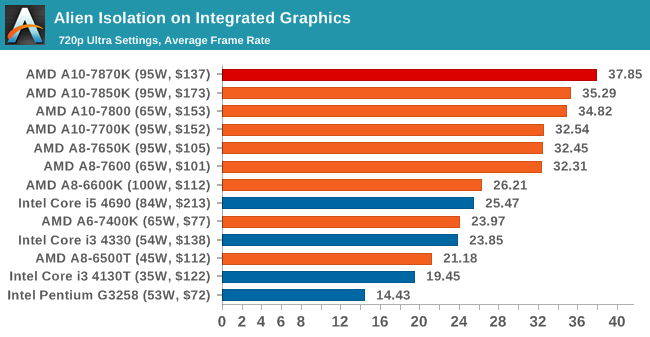
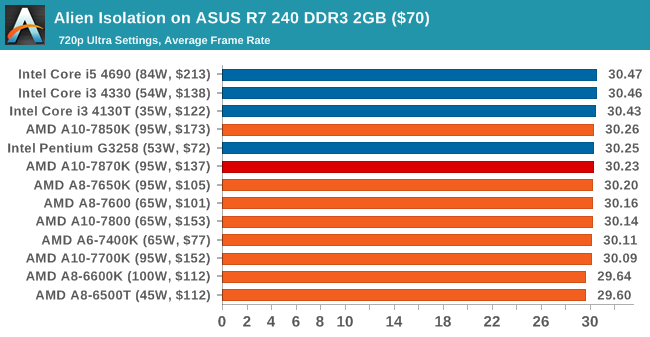
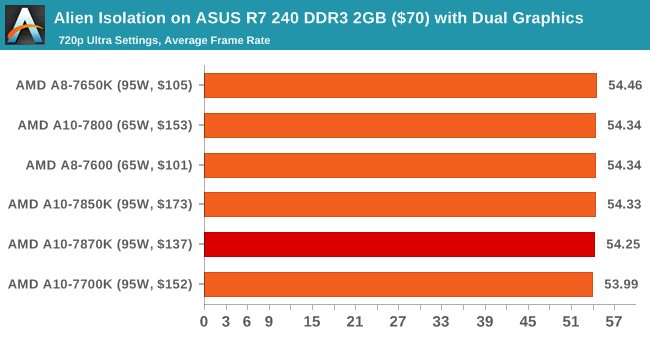
Total War: Attila
The Total War franchise moves on to Attila, another The Creative Assembly development, and is a stand-alone strategy title set in 395AD where the main story line lets the gamer take control of the leader of the Huns in order to conquer parts of the world. Graphically the game can render hundreds/thousands of units on screen at once, all with their individual actions and can put some of the big cards to task.
For low end graphics, we test at 720p with performance settings, recording the average frame rate. With mid and high range graphics, we test at 1080p with the quality setting. In both circumstances, unlimited video memory is enabled and the in-game scripted benchmark is used.
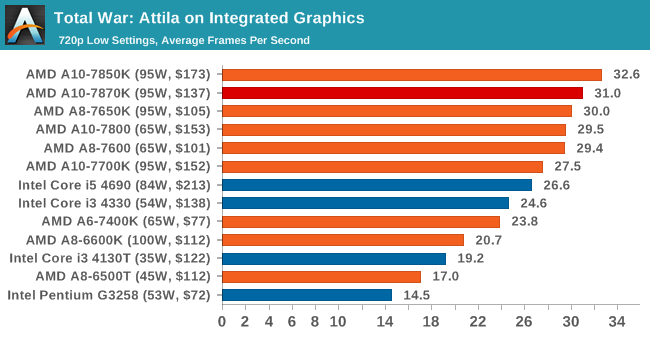
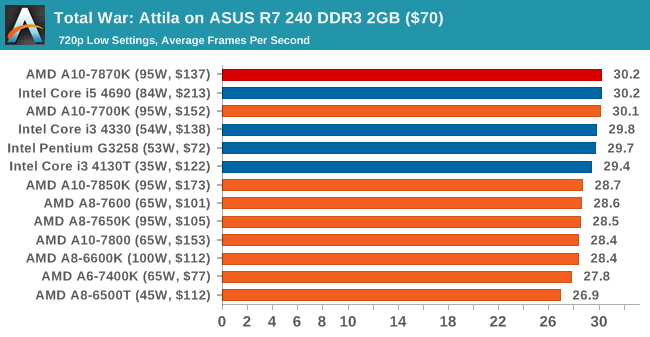
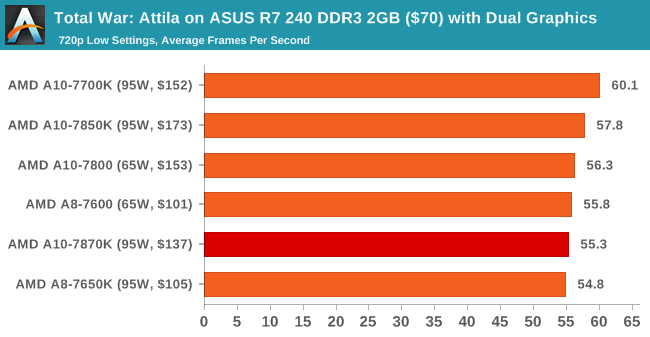
Grand Theft Auto V
The highly anticipated iteration of the Grand Theft Auto franchise finally hit the shelves on April 14th 2015, with both AMD and NVIDIA in tow to help optimize the title. GTA doesn’t provide graphical presets, but opens up the options to users and extends the boundaries by pushing even the hardest systems to the limit using Rockstar’s Advanced Game Engine. Whether the user is flying high in the mountains with long draw distances or dealing with assorted trash in the city, when cranked up to maximum it creates stunning visuals but hard work for both the CPU and the GPU.
For our test we have scripted a version of the in-game benchmark, relying only on the final part which combines a flight scene along with an in-city drive-by followed by a tanker explosion. For low end systems we test at 720p on the lowest settings, whereas mid and high end graphics play at 1080p with very high settings across the board. We record both the average frame rate and the percentage of frames under 60 FPS (16.6ms).
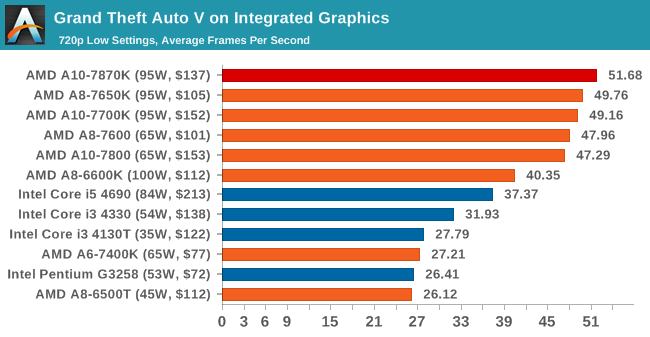
![Grand Theft Auto V on Integrated Graphics [Under 60 FPS]](https://images.anandtech.com/graphs/graph9307/74850.png)
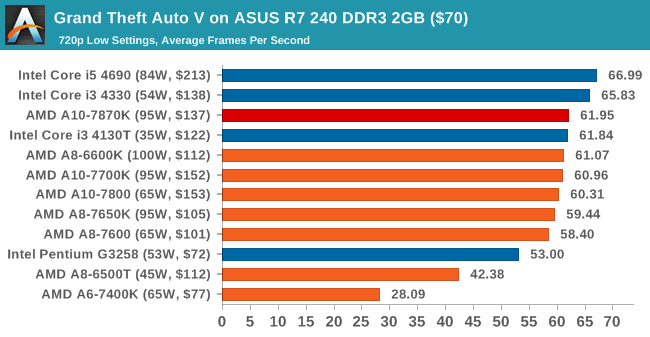
![Grand Theft Auto V on ASUS R7 240 DDR3 2GB ($70) [Under 60 FPS]](https://images.anandtech.com/graphs/graph9307/74858.png)
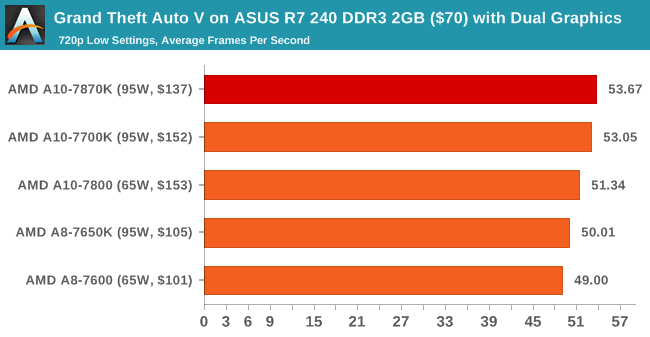
![Grand Theft Auto V on ASUS R7 240 DDR3 2GB ($70) with Dual Graphics [Under 60 FPS]](https://images.anandtech.com/graphs/graph9307/74866.png)
GRID: Autosport
No graphics tests are complete without some input from Codemasters and the EGO engine, which means for this round of testing we point towards GRID: Autosport, the next iteration in the GRID and racing genre. As with our previous racing testing, each update to the engine aims to add in effects, reflections, detail and realism, with Codemasters making ‘authenticity’ a main focal point for this version.
GRID’s benchmark mode is very flexible, and as a result we created a test race using a shortened version of the Red Bull Ring with twelve cars doing two laps. The car is focus starts last and is quite fast, but usually finishes second or third. For low end graphics we test at 1080p medium settings, whereas mid and high end graphics get the full 1080p maximum. Both the average and minimum frame rates are recorded.
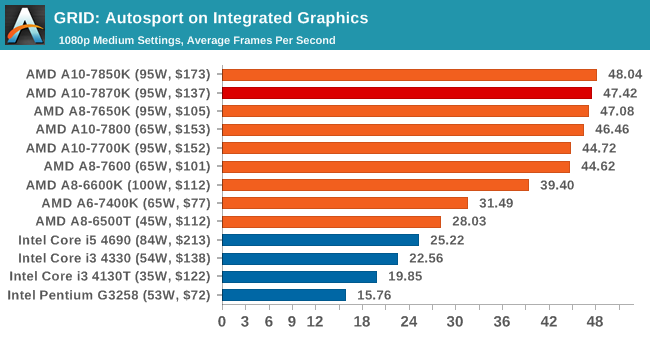
![GRID: Autosport on Integrated Graphics [Minimum FPS]](https://images.anandtech.com/graphs/graph9307/74852.png)
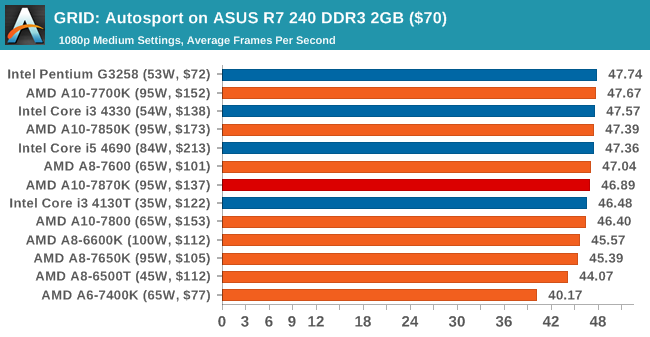
![GRID: Autosport on ASUS R7 240 DDR3 2GB ($70) [Minimum FPS]](https://images.anandtech.com/graphs/graph9307/74860.png)
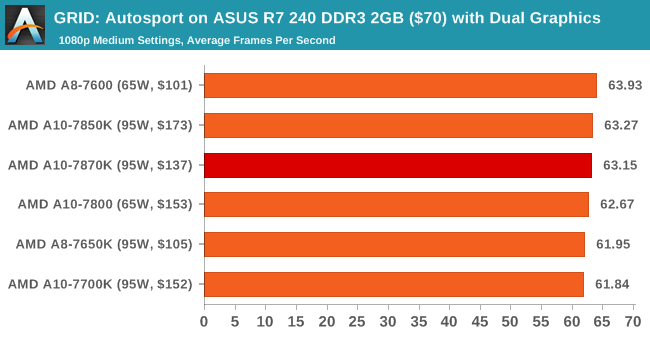
![GRID: Autosport on ASUS R7 240 DDR3 2GB ($70) with Dual Graphics [Minimum FPS]](https://images.anandtech.com/graphs/graph9307/74868.png)
Middle-Earth: Shadows of Mordor
The final title in our testing is another battle of system performance with the open world action-adventure title, Shadows of Mordor. Produced by Monolith using the LithTech Jupiter EX engine and numerous detail add-ons, SoM goes for detail and complexity to a large extent, despite having to be cut down from the original plans. The main story itself was written by the same writer as Red Dead Redemption, and it received Zero Punctuation’s Game of The Year in 2014.
For testing purposes, SoM gives a dynamic screen resolution setting, allowing us to render at high resolutions that are then scaled down to the monitor. As a result, we get several tests using the in-game benchmark. For low end graphics we examine at 720p with low settings, whereas mid and high end graphics get 1080p Ultra. The top graphics test is also redone at 3840x2160, also with Ultra settings, and we also test two cards at 4K where possible.
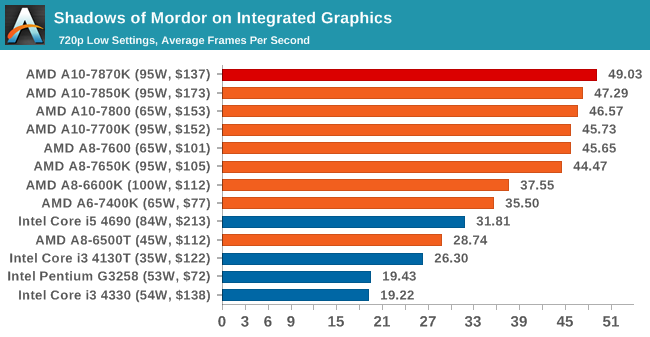
![Shadows of Mordor on Integrated Graphics [Minimum FPS]](https://images.anandtech.com/graphs/graph9307/74854.png)
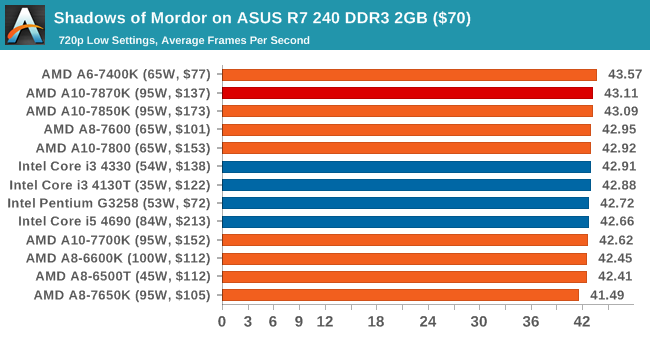
![Shadows of Mordor on ASUS R7 240 DDR3 2GB ($70) [Minimum FPS]](https://images.anandtech.com/graphs/graph9307/74862.png)
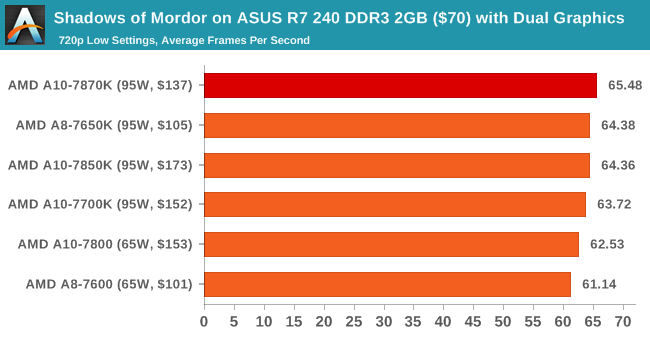
![Shadows of Mordor on ASUS R7 240 DDR3 2GB ($70) with Dual Graphics [Minimum FPS]](https://images.anandtech.com/graphs/graph9307/74870.png)
Conclusions on Low-End Graphics
While the extra 20% IGP frequency doesn’t translate into massive improvements in frame rates, almost every game saw a small bump in the performance, which is sometimes all you need to get a good 30/60 FPS average. Our dual graphics testing was influenced even less by the IGP frequency increase, but the A10-7870K does take the title of the fastest integrated graphics on the market with the benefit of being socketed.















140 Comments
View All Comments
anubis44 - Wednesday, June 3, 2015 - link
Dual-core CPUs are dead men walking for gaming. If you've already got one, fine, you'll have to upgrade very soon. But recommending buying a dual-core chip NOW is uttery unconsionable, unless it's for your grandmother to play solitaire. The damn thing will choke just running windows and a web browser these days.anubis44 - Wednesday, June 3, 2015 - link
@RafaelHershel: "Less power means less heat and less noise. It also means better performance in a (very) small case. It also means a more modest PSU."But it's a question of proportion. How much money do you think you're saving in electricity by paying a lot more for an Intel processor? Check this out:
https://www.youtube.com/watch?v=fBeeGHozSY0
Not to mention in buying Intel and nVidia, you're supporting two companies with proven track records of ripping off customers, but please go right ahead and blithely do it.
jonez - Friday, June 5, 2015 - link
Why use a 4 years old linux distribution, it's even older than most of the hardware being benchmarked?And running it live it's not ideal too, but for the purpose of intra-comparison it's not that relevant, I guess.
ES_Revenge - Saturday, June 6, 2015 - link
I still don't understand why the Dual Graphics tests are not including Frame-Time Variance numbers/charts. It's one thing to have nice FPS from Dual Graphics but if the FTV is bad enough that it makes it no better than being on the solo-card (or the APU solo) then those numbers quickly become meaningless. Anandtech has commented on dual-GPU FTV stuff before, so I'm puzzled as to why it's not even mentioned as even a possible concern here with the Dual Graphics tests of the last few AMD APUs.ssv - Wednesday, June 10, 2015 - link
totally, off the track. Why is that AMD architectures are named after Indian rivers? Kaveri and Godavari are rivers in south India. I am not sure if earlier "Bima" refers to Bhima (indian again) mythological character.P39Airacobra - Sunday, June 21, 2015 - link
Sorry but 30fps at low settings and 720p is not what I would consider gaming capable! These APU's are just a waste of money! You can buy a X4 860K CPU and a old R7 260 for about the same price and actually be able to game!ricster7227@gmail.com - Tuesday, July 21, 2015 - link
I am presently running the A 5800 k APU for a couple + years and have waited a few cycles here and will take the plunge for this new chip. I presently OC to 5600 with an H-105 pushpull at about 36 degrees under load and it will be interesting to see the difference in performance and operation. I suspect this will improve my experience until my next build I7 or Zeons with ECC.ricster7227@gmail.com - Sunday, August 23, 2015 - link
The new APU is much stronger and faster than my A 5800 k. It is clocked at4400 which is slower however it is much faster for the normal office and light gaming. I can now do intensive rendering, watch and record HD video and surf the web at the same time. It stays under 30 degrees, doesn't slow down and hasn't crashed at all. I'm running the latest Insider 2010. It is a welcome addition and has increased my productivity by about double overall.gearhead99 - Monday, September 28, 2015 - link
the APU stuff is great for laptops, gimme gimme, but i don't see a good case for AM1 or FM2+. flexible upgrade path - no / cheap ECC - no / good IPC - no / good TDP - no / many cpu cores - no / low price - no. its especially unfortunate AMD has abandoned ECC. regardless of all the groaning over IPC, the bang4buck was pretty solid on AM2>AM3+SviatA - Friday, October 16, 2015 - link
Honestly, I wouldn't buy any video card in addition to any AMD APU. For me, gaming performance of my build is irrelevant since I don't like playing games. So if you are not going to do that (or use Adobe Photoshop for photo editing) then forget about Intel. APUs are good enough on power consumption and performance for simple home tasks.The only issue is that AMD doesn't really develop its processors. Which is a shame since they could give us impressive stuff. http://hardware.nl/amd/ad7600ybjabox.html - less than a 100, but performance wise, it will work fine.